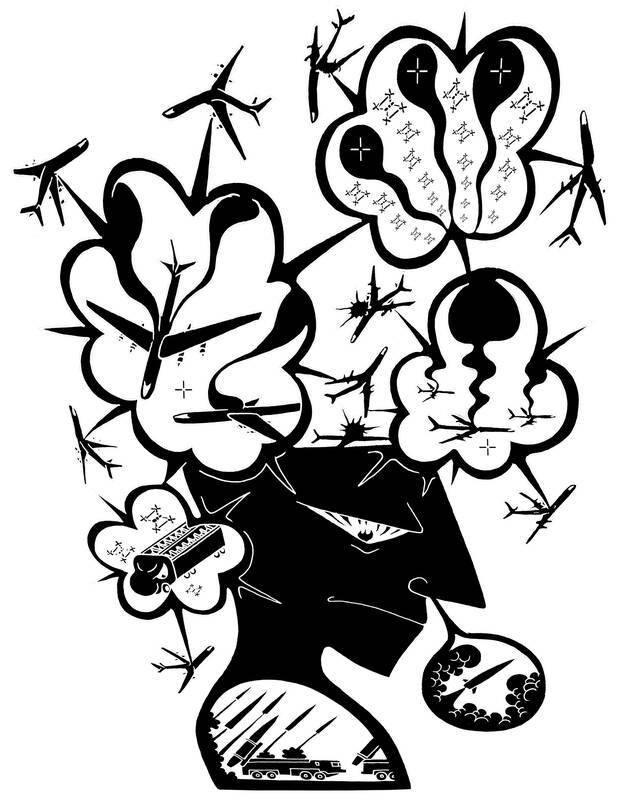Satellite imagery of a Russian air base taken shortly after Ukraine carried out a drone attack deep inside Russia over the weekend shows several strategic bombers were destroyed and badly damaged, three open source analysts said.
Ukraine targeted at least four air bases across Russia using 117 uncrewed aerial vehicles launched from containers close to the targets. Drone footage of the operation verified by Reuters shows several aircraft were struck in at least two locations.
Capella Space, a satellite company, supplied Reuters with an image of one of those airfields, in the Siberian region of Irkutsk. The image was taken on Monday, the day after one of the most complex and effective operations launched by Ukraine in more than three years of war.

Illustration: Mountain People
Cloud cover can obscure conventional satellite pictures, but the data are from synthetic aperture radar (SAR) satellites, which direct energy beams at the Earth and detect echoes, making it possible to identify small topographical details.
The image — more grainy than conventional high-resolution photographs, and in black and white — appears to show the debris of several aircraft along the runway of the Belaya military air base or parked in protective revetments nearby.
“Based on the debris visible, comparison to recent satellite images and released drone footage from Telegram posted to Twitter, I can see the destruction of several aircraft,” said John Ford, a research associate at the California-based James Martin Center for Nonproliferation Studies.
Ford said that SAR imagery provided to him by Reuters showed what appeared to be the remnants of two destroyed Tu-22 Backfires — long-range, supersonic strategic bombers that have been used to launch missile strikes against Ukraine.
The SAR image, as well as drone footage of the strikes posted on social media, also indicated that four strategic Tu-95 heavy bombers had been destroyed or severely damaged, he added.
Brady Africk, an open source intelligence analyst, agreed that the SAR imagery of Irkutsk air base showed several Tu-95s and Tu-22s had been destroyed and damaged, although more imagery was needed to properly assess the impact.
“But it is clear that the attack on this air base was very successful,” he said. “The aircraft targeted in the attack were a mix of Tu-22 and Tu-95 bombers, both of which Russia has used to launch strikes against Ukraine.”
Belaya air base is home to several flat decoy aircraft, Africk said, adding that they had apparently failed to mislead Ukrainian drones in this case.
Reuters has not yet obtained SAR imagery of the Olenya airfield, a base in Murmansk in Russia’s far northwest that was also attacked.
However, drone video footage of Olenya base provided by Ukrainian authorities and verified by Reuters showed two burning bombers, which appeared to be Tu-95s, and a third, also a Tu-95, being hit by a large explosion.
The Russian Ministry of Defense said that Ukraine had launched drone strikes targeting military airfields in Murmansk, Irkutsk, Ivanovo, Ryazan and Amur regions.
Air defenses repelled the assaults in three regions, but not Murmansk and Irkutsk, it said, adding that in those places, several aircraft caught fire.
The Kremlin on Tuesday said that Russia had launched an official investigation into the weekend Ukrainian drone attacks.
Top Russian security official Dmitry Medvedev also said, in an apparent response to the strikes on Russian strategic bomber bases, that Moscow would take revenge.
Ukraine’s domestic security agency, the SBU, has claimed responsibility for the operation, called “Spider’s Web,” and said that in total 41 Russian warplanes were hit.
Ukrainian President Volodymyr Zelenskiy called the attack, which struck targets up to 4,300km from the frontlines of the war, “absolutely brilliant.”
The Ukrainian military initially added 12 aircraft to its running tally of Russia’s wartime military losses on Tuesday.
“After processing additional information from various sources and verifying it ... we report that the total [Russian] losses amounted to 41 military aircraft, including strategic bombers and other types of combat aircraft,” it added in a later update.
There was no immediate public response from Moscow to the SBU statement.
The SBU said the damage caused by the operation amounted to US$7 billion, and 34 percent of the strategic cruise missile carriers at Russia’s main airfields were hit.
Reuters could not independently verify the claims.
Some experts said the operation would not be enough to stop Russia from launching missile attacks on Ukraine using strategic bombers, but it would be hard, if not impossible, to replace the damaged planes because some of them are no longer in production.
The attack was also likely to force Russia to reconfigure its air defenses, the Institute for the Study of War research group said.
The “operation will force Russian officials to consider redistributing Russia’s air defense systems to cover a much wider range of territory and possibly deploying mobile air defense groups that can more quickly react to possible similar Ukrainian drone strikes in the future,” the institute said.

Taiwan stands at the epicenter of a seismic shift that will determine the Indo-Pacific’s future security architecture. Whether deterrence prevails or collapses will reverberate far beyond the Taiwan Strait, fundamentally reshaping global power dynamics. The stakes could not be higher. Today, Taipei confronts an unprecedented convergence of threats from an increasingly muscular China that has intensified its multidimensional pressure campaign. Beijing’s strategy is comprehensive: military intimidation, diplomatic isolation, economic coercion, and sophisticated influence operations designed to fracture Taiwan’s democratic society from within. This challenge is magnified by Taiwan’s internal political divisions, which extend to fundamental questions about the island’s identity and future
Media said that several pan-blue figures — among them former Chinese Nationalist Party (KMT) chairwoman Hung Hsiu-chu (洪秀柱), former KMT legislator Lee De-wei (李德維), former KMT Central Committee member Vincent Hsu (徐正文), New Party Chairman Wu Cheng-tien (吳成典), former New Party legislator Chou chuan (周荃) and New Party Deputy Secretary-General You Chih-pin (游智彬) — yesterday attended the Chinese Communist Party’s (CCP) military parade commemorating the 80th anniversary of the end of World War II. China’s Xinhua news agency reported that foreign leaders were present alongside Chinese President Xi Jinping (習近平), such as Russian President Vladimir Putin, North Korean leader Kim
Taiwan People’s Party (TPP) Chairman Huang Kuo-chang (黃國昌) is expected to be summoned by the Taipei City Police Department after a rally in Taipei on Saturday last week resulted in injuries to eight police officers. The Ministry of the Interior on Sunday said that police had collected evidence of obstruction of public officials and coercion by an estimated 1,000 “disorderly” demonstrators. The rally — led by Huang to mark one year since a raid by Taipei prosecutors on then-TPP chairman and former Taipei mayor Ko Wen-je (柯文哲) — might have contravened the Assembly and Parade Act (集會遊行法), as the organizers had
Minister of Foreign Affairs Lin Chia-lung (林佳龍) last week made a rare visit to the Philippines, which not only deepened bilateral economic ties, but also signaled a diplomatic breakthrough in the face of growing tensions with China. Lin’s trip marks the second-known visit by a Taiwanese foreign minister since Manila and Beijing established diplomatic ties in 1975; then-minister Chang Hsiao-yen (章孝嚴) took a “vacation” in the Philippines in 1997. As Taiwan is one of the Philippines’ top 10 economic partners, Lin visited Manila and other cities to promote the Taiwan-Philippines Economic Corridor, with an eye to connecting it with the Luzon